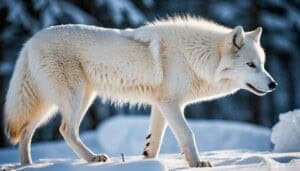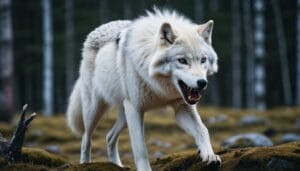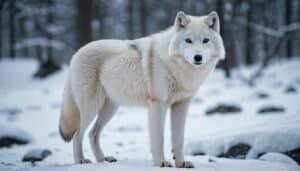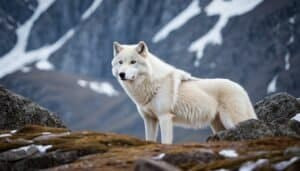Introduction
The Arctic wolf, a fascinating and resilient predator, possesses one of the most powerful bite forces among canids
This article delves into the specifics of an Arctic wolf’s bite force, comparing it with other wolves and animals, exploring the reasons behind its strength, and examining its crucial role in hunting and survival in the harsh Arctic environment
We will also discuss how scientists measure this bite force and the potential damage it can cause
Understanding the Arctic Wolf’s Bite Force
The Arctic wolf’s bite force is a significant aspect of its survival and predatory skills. This section explores the average bite force, how it compares to other wolves, and the reasons behind its formidable strength
Average Bite Force of an Arctic Wolf
The average bite force of an Arctic wolf is an impressive 406 pounds per square inch (PSI). This powerful bite allows the wolf to break through the tough hides of its prey, which often include large and well-defended animals like musk oxen and caribou
The strength of the Arctic wolf’s bite is not just about the raw numbers; it’s also about the structure and functionality of its jaws and teeth. These wolves have evolved to have strong jaw muscles and sharp, durable teeth, ideal for gripping and tearing flesh, which is essential for their survival in the challenging Arctic environment
Comparison with Other Wolves
When compared to other wolves, the Arctic wolf’s bite force is relatively similar but has some distinctions due to its unique habitat and diet. For instance, the gray wolf, which inhabits a variety of regions, has a bite force ranging from 400 to 500 PSI, depending on its size and diet
While the bite force of the Arctic wolf falls within this range, its bite is often considered more adapted for dealing with larger and tougher prey found in the Arctic regions
The difference is not just in the numbers but in the specific adaptations that each type of wolf has developed to survive in their respective environments.
Reasons Behind Strong Bite Forces
The strength of an Arctic wolf’s bite force can be attributed to several factors. Firstly, their primary prey, such as musk oxen and caribou, have thick hides and sturdy bones, requiring a powerful bite to penetrate
The harsh Arctic climate also means that food can be scarce, necessitating efficient hunting and feeding strategies. Evolution has favored wolves with stronger bites, as these individuals are more successful hunters and thus more likely to survive and reproduce
Additionally, the Arctic wolf’s strong bite is essential for defending their territory and packs from other predators, ensuring their dominance in the ecosystem
The combination of powerful jaw muscles, sharp teeth, and the necessity of dealing with large, tough prey has led to the development of the Arctic wolf’s impressive bite force
Bite Force in Hunting and Survival
An Arctic wolf’s bite force is crucial for its hunting techniques and overall survival in the extreme conditions of the Arctic. This section explores how their bite force plays a role in their hunting strategies and their importance for survival in such a harsh environment
Role in Hunting Techniques
Arctic wolves rely heavily on their bite force when hunting. Their powerful jaws allow them to effectively capture and kill their prey, which includes musk oxen, caribou, and Arctic hares
When hunting in packs, wolves often use their bite force to hold onto and immobilize larger prey, allowing other pack members to bring the animal down. This cooperative hunting strategy is essential for taking down larger prey that would be difficult for a single wolf to manage
The strong bite force also helps in quickly dispatching the prey, minimizing the struggle and reducing the risk of injury to the wolf
Their bite force is not just about power; it’s also about precision. Arctic wolves have evolved to have a bite that can crush bones and tear flesh, but they can also use their jaws delicately when needed, such as when carrying pups or food to their den. This versatility is crucial for their survival, as it allows them to adapt their hunting techniques to different types of prey and situations
Importance for Survival in the Arctic
Survival in the Arctic is no easy feat, and the Arctic wolf’s bite force plays a significant role in this. The extreme cold and scarcity of food mean that every hunting opportunity must be maximized. A powerful bite force ensures that the wolves can successfully hunt and consume their prey, which is vital for maintaining their energy levels in the cold
Additionally, the ability to crush bones allows Arctic wolves to access marrow, which is a rich source of nutrients, further enhancing their ability to survive in the harsh environment
Furthermore, the strong bite force aids in territorial defense. In the Arctic, where resources are limited, defending territory from other predators and rival packs is crucial. The ability to inflict serious damage with a bite helps deter intruders and protect the pack’s resources. This defensive capability is essential for the wolves’ survival, ensuring they have access to the necessary food and safe areas for their pups
The combination of these factors highlights how integral a powerful bite force is to the Arctic wolf’s hunting techniques and overall survival strategy
Measuring and Comparing Bite Forces
Understanding the Arctic wolf’s bite force involves various methods of measurement and comparison with other animals. This section delves into how scientists measure bite forces, comparisons with other species, and the potential damage an Arctic wolf’s bite can inflict
Methods of Measurement
Measuring the bite force of an Arctic wolf involves several scientific techniques. One common method is using a bite force transducer, a device that wolves bite into, which records the pressure exerted
This device is often covered with materials that mimic the texture of prey to ensure accurate readings. Another method involves analyzing skull and jawbone structure through imaging techniques like CT scans and MRI, which allow scientists to estimate bite force based on the size and shape of the jaw muscles and bones
These measurements can then be corroborated with data from living wolves to ensure accuracy
In some cases, researchers may also observe and record bite force indirectly by analyzing the damage to prey animals’ bones and tissues. By comparing the marks left on bones with known forces required to produce such marks, scientists can estimate the bite force
These methods provide a comprehensive understanding of the Arctic wolf’s bite capabilities and how they compare to other animals
Comparisons with Other Animals
When comparing the Arctic wolf’s bite force to other animals, it stands out as one of the strongest among canids but is surpassed by some larger predators. For example, the gray wolf has a similar bite force, typically ranging between 400 and 500 PSI, depending on the individual and its environment
However, the bite force of larger predators such as the lion, which can reach up to 650 PSI, and the hyena, with a bite force of around 1,100 PSI, is significantly higher. These differences are often due to variations in diet, prey size, and evolutionary adaptations
Despite not having the highest bite force among predators, the Arctic wolf’s bite is perfectly suited for its ecological niche. Its bite force is strong enough to take down and consume the large, tough animals found in its Arctic habitat, making it an effective and efficient predator in its environment
Potential Damage and Impact
The potential damage inflicted by an Arctic wolf’s bite is considerable. With a bite force of 406 PSI, these wolves can easily crush bones and tear through thick hides. This capability is crucial for their survival, as it allows them to access the nutrient-rich marrow inside the bones of their prey
The bite’s power also means that a single wolf can deliver a fatal bite to its prey, which is essential for hunting large and potentially dangerous animals like musk oxen and caribou
The impact of an Arctic wolf’s bite goes beyond just hunting. In territorial disputes or defensive situations, the bite can cause significant injuries to rivals or predators, deterring them from further confrontation. This defensive use of bite force helps protect the pack and its resources, ensuring the survival of its members
Conclusion
The Arctic wolf, with its formidable bite force, exemplifies the adaptability and resilience necessary for survival in one of the Earth’s most extreme environments. With an average bite force of 406 PSI, this predator is well-equipped to handle the challenges of hunting large, tough prey like musk oxen and caribou
The comparison of their bite force to other wolves and predators highlights their unique adaptations for the Arctic habitat. The Arctic wolf’s bite force is crucial not only for securing food but also for defending territory and ensuring the survival of their pack
Understanding the methods used to measure their bite force, and the potential damage it can inflict, underscores the importance of this adaptation in their daily lives. Overall, the Arctic wolf’s bite force is a key factor in its predatory success and a testament to its evolutionary prowess










